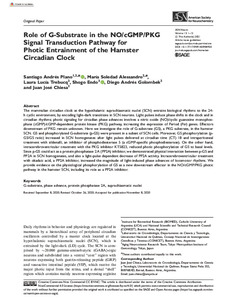Por favor, use este identificador para citar o enlazar este ítem:
https://repositorio.uca.edu.ar/handle/123456789/11524| Título: | Role of G-substrate in the NO/cGMP/PKG signal transduction pathway for photic entrainment of the hamster circadian clock | Autor: | Plano, Santiago Andrés Alessandro, María Soledad Trebucq, Laura Lucía Endo, Shogo Golombek, Diego A. Chiesa, Juan José |
Palabras clave: | NUCLEO SUPRAQUIASMATICO; PROTEíNA FOSFATASA 2A; SISTEMA NERVIOSO CENTRAL; LUZ; RITMO CIRCADIANO | Fecha de publicación: | 2021 | Editorial: | SAGE Publishing | Cita: | Plano, S. A., Alessandro, M. S., Trebucq, L. L., Endo, S., Golombek, D. A., Chiesa, J. J. Role of G-substrate in the NO/cGMP/PKG signal transduction pathway for photic entrainment of the hamster circadian clock [en línea]. American Society for Neurochemistry. 2021, 13(1-12). Doi: 10.1177/1759091420984920. Disponible en: https://repositorio.uca.edu.ar/handle/123456789/11524 | Resumen: | Abstract: The mammalian circadian clock at the hypothalamic suprachiasmatic nuclei (SCN) entrains biological rhythms to the 24- h cyclic environment, by encoding light-dark transitions in SCN neurons. Light pulses induce phase shifts in the clock and in circadian rhythms; photic signaling for circadian phase advances involves a nitric oxide (NO)/cyclic guanosine monophosphate (cGMP)/cGMP-dependent protein kinase (PKG) pathway, increasing the expression of Period (Per) genes. Effectors downstream of PKG remain unknown. Here we investigate the role of G-substrate (GS), a PKG substrate, in the hamster SCN. GS and phosphorylated G-substrate (p-GS) were present in a subset of SCN cells. Moreover, GS phosphorylation (p- GS/GS ratio) increased in SCN homogenates after light pulses delivered at circadian time (CT) 18 and intraperitoneal treatment with sildenafil, an inhibitor of phosphodiesterase 5 (a cGMP-specific phosphodiesterase). On the other hand, intracerebroventricular treatment with the PKG inhibitor KT5823, reduced photic phosphorylation of GS to basal levels. Since p-GS could act as a protein phosphatase 2 A (PP2A) inhibitor, we demonstrated physical interaction between p-GS and PP2A in SCN homogenates, and also a light-pulse dependent decrease of PP2A activity. Intracerebroventricular treatment with okadaic acid, a PP2A inhibitor, increased the magnitude of light-induced phase advances of locomotor rhythms. We provide evidence on the physiological phosphorylation of GS as a new downstream effector in the NO/cGMP/PKG photic pathway in the hamster SCN, including its role as a PP2A inhibitor. | URI: | https://repositorio.uca.edu.ar/handle/123456789/11524 | ISSN: | 1759-0914 (on line) | Disciplina: | MEDICINA | DOI: | 10.1177/1759091420984920 | Derechos: | Atribución-NoComercial-CompartirIgual 4.0 Internacional | Fuente: | American Society for Neurochemistry. 2021, 13(1-12) |
| Aparece en las colecciones: | Artículos |
Ficheros en este ítem:
| Fichero | Descripción | Tamaño | Formato | |
|---|---|---|---|---|
| role-substrate-no-cgmp-pkg.pdf | 1,15 MB | Adobe PDF |  Visualizar/Abrir |
Visualizaciones de página(s)
101
comprobado en 27-abr-2024
Descarga(s)
114
comprobado en 27-abr-2024
Google ScholarTM
Ver en Google Scholar
Altmetric
Altmetric
Este ítem está sujeto a una Licencia Creative Commons

